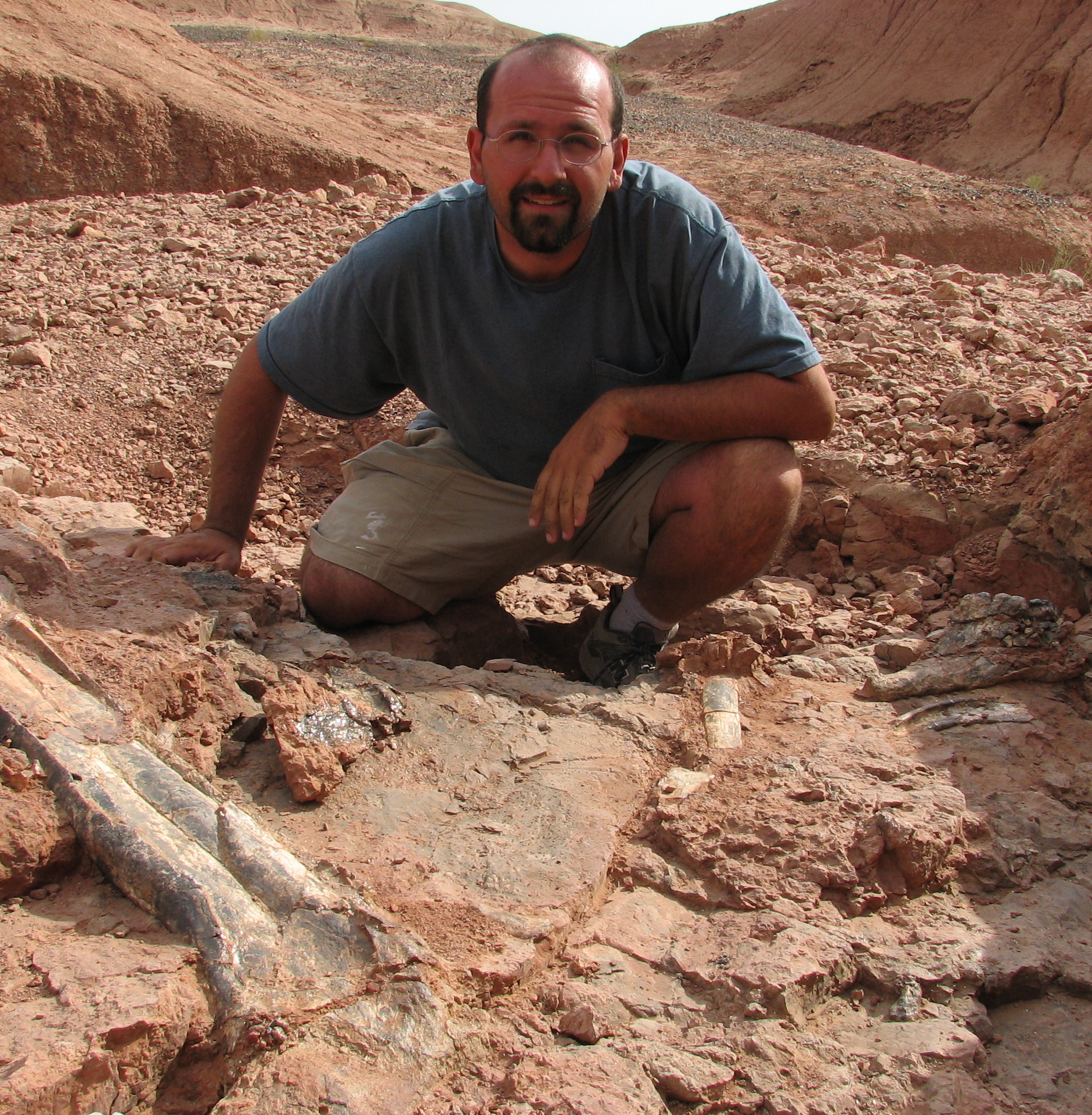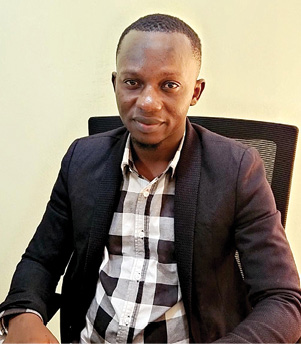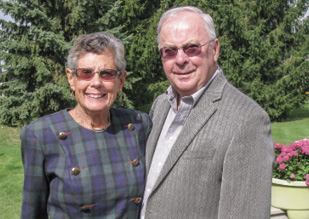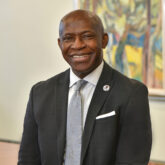The answer is often in the details.
And it was while studying the details that vertebrate paleontologist Dr. Frank Varriale ’97 made a key discovery in dinosaur jaw mechanics: Jaws of the ceratopsian dinosaurs moved forward and backward as well as up and down.

Using casts of the fossils of the horned, plant-eating dinosaurs, Dr. Varriale used a scanning electron microscope to scrutinize all the tiny bits of evidence of wear-and-tear to the teeth as the dinosaur chewed. The length, width, location and shape of these microwears helped Dr. Varriale determine a lot about the dinosaur–the food it ate and how it chewed, and the ultimate clue to his ground-breaking discovery: the shape of the damage lines on teeth. His article, “Dental microwear reveals mammal-like chewing in the neoceratopsian dinosaur ‘Leptoceratops gracilis,’” was published in July 2016 in the peer-reviewed journal PeerJ.
As part of his research, Dr. Varriale traveled to several national and international museums to examine ceratopsian teeth, including the National Museum of Natural History, Smithsonian Institution, in Washington, D.C.; Beijing Natural History Museum; Canadian Museum of Nature in Ottawa, Ontario, Canada; the Mongolian Academy of Sciences in Ulaanbaatar; and the Palaeozoological Institute of the Polish Academy of Sciences in Warsaw.
He has been an assistant professor of biology at King’s College in Wilkes-Barre, Pa., since 2012. He was awarded the Alfred Sherwood Romer Prize from the Society of Vertebrate Paleontology for his research that resulted a revolutionary discovery of chewing in horned dinosaurs (ceratopsians). Dr. Varriale earned a master’s in paleontology from South Dakota School of Mines and Technology and a doctorate at Johns Hopkins University School of Medicine in the university’s Center for Functional Anatomy and Evolution.
Varriale teaches a variety of courses, including evolution and diversity, comparative vertebrate anatomy, earth science, anatomy and physiology, and a new dinosaurs course for non-majors in spring 2017.
An interview with Dr. Varriale
Why did you choose zoology as a start to your career as a vertebrate paleontologist?
The choice was quite simple: I’ve always had a passion for paleontology, specifically the branch of vertebrate paleontology involved with the study of dinosaurs, their biology and ecology. The logical place to start an undergraduate career in paleontology is either the disciplines of geology or biology. When I began my career, Oswego was the only school in the SUNY system that offered a B.S. in zoology. Much of our understanding of behavior, biology and function of dinosaurs comes from comparison of extinct animals with living close relatives or analogues, making zoology an excellent place to start when trying to build a foundation of knowledge on which to study extinct animals.
Readers (well, people in general) are fascinated by your career. Can you share an anecdote that illustrates what your job is like?
Perhaps the most rewarding aspect of my career is the “eureka moment” of scientific discovery. That moment when you understand how something works, and that what you’ve discovered is entirely new knowledge that was unknown to humanity before that moment. This is certainly not a phenomenon limited to my discipline, but it is an experience that scientists derive great joy from. My moment came when I was looking at teeth of horned dinosaurs (ceratopsians) using scanning electron microscopy (SEM). I was in a room on the basement floor of the physiology building at Johns Hopkins University. The room was dark so that you could more easily see the monitor of the SEM. I had viewed several teeth from the lower jaw of a medium-sized ceratopsian known as Leptoceratops when I had noticed wear on the teeth that was unlike the pits and scratches I had seen on other ceratopsians. From this, a suspicion grew in my mind about the way this animal was moving its lower jaw when chewing, and I made several predictions about what the wear should look like on the upper teeth once I started to examine them. When it came time to view the upper teeth, the pattern I had predicted was present, and in that moment I realized I had found a new behavior significant to the evolution of these dinosaurs, one that had not been discovered before. I was so excited I wanted to share the moment with someone who would appreciate its significance. My advisor, being the only other dinosaur paleontologist present in the vast sea of medical professionals at Hopkins Medical School, fit the bill. His research is also founded on understanding the evolution of chewing in duck-billed dinosaurs and their relatives, so I knew he would immediately appreciate the discovery. I flung myself out of the room and tore through several other buildings to get to him and tell him what I had found. Eureka!
What was the value of SUNY Oswego’s program to your career?
The immediate value of the zoology program at Oswego was the opportunity to receive an education that was more specialized toward my career goals. Courses founded on the diversity, evolution, behavior, structure and function of living back-boned animals. I have used this foundation throughout my career as a paleontologist.
During my time at Oswego, professors Peter Weber and Al Lackey recognized my passion for paleontology and provided career advice that I otherwise would not have known to seek out. Their door was always open, and I often found myself spending time in their offices discussing evolution, dinosaurs and my career. As busy as their lives were, they certainly weren’t required to do this, but now as a professor I see that they were just as rewarded by encouraging a budding young scientist as that pupil was to sit in their presence and be edified. Their outgoing investments in me led me to take as many courses taught by them as I could. Their teaching style was rigorous, their expectations high, and I often find myself emulating aspects of their technique in my own courses. To this day, their wisdom is still being passed on, as I was recently discussing with one of my top students the rewards of lifelong learning that Peter imparted to me over 20 years ago.
More from Alumni Profiles
Astrophysicist, Yale Professor Credits Oswego with Setting His Course for Stellar Career
Astrophysicist, Yale Professor Credits Oswego with Setting His Course for Stellar Career Earl Bellinger ’12 is one stellar guy. A quick review …
BHI Alumnus from Liberia Gains World of Experience
BHI Alumnus from Liberia Gains World of Experience Otis Gbala M’23 became the first SUNY Oswego graduate who studied from Liberia …
Couple’s Loyal Support for Oswego Spans Five Decades
Couple’s Loyal Support for Oswego Spans Five Decades Marilynn “Lynn” Nagy Farrar ’61 and Neil Farrar cherish their memories of Oswego …












Leave A Reply
[…] Read the Online Exclusive interview with Dr. Varriale […]